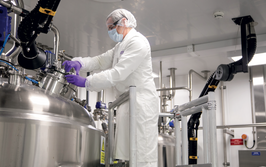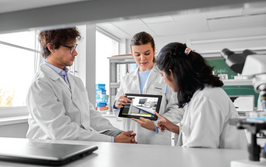Drug Discovery’s Digital Future
From AI to integrated in silico systems and less reliance on animal testing. We ask an expert from Elsevier about the future of digital tech in drug discovery.
| 7 min read | Interview

Historically, the translation of new medicines from the preclinical to the clinical stages has relied on manual, time-consuming processes that have a high rate of failure – 93 percent of drugs entering clinical trials do not secure regulatory approval. Researchers can spend months gathering data from numerous scientific articles on the potential toxicity of their drug, as well as its potential adverse events, dose selection, and how it compares to other drugs on the market. This data is then spread across different sources internally and externally, and in varied formats.
A need therefore arose to design a platform to provide this data in a single place, and in a standardized and interoperable format. When PharmaPendium was launched in 2009, its primary function was to help pharma companies increase the success of their regulatory submissions so more new treatments could reach patients sooner. Regulatory documents have always been core to PharmaPendium but, in its latest version, Elsevier and the FDA have collaborated on digitizing regulatory content, including labels, summary approval packages, and Advisory Committee Meeting documents.
The datasets produced need to be efficient enough to be machine readable and available for off-platform use so researchers can quickly embed data into their workflows. Packaging data in this way is now enabling pharma companies to safeguard their investments by making faster, more informed decisions about what drug candidates to advance. Olivier Barberan, Director of Translational Medicines Solutions at Elsevier, tells us more about the platform – and offers a glimpse into the future of drug discovery and development.
How can the platform help the drug discovery process?
Data analysis that would have taken months typically now takes half a day with the packaged data in PharmaPendium. The search, analytics, and predictive capabilities in the platform help accelerate drug development approvals, including drug safety tests, clinical trial design, and post-market surveillance. We specifically designed the tool to be as user friendly as possible. For example, the quick search bar facilitates search across a range of information from quantitative data to full text. Users can navigate through drugs, adverse effects, targets, and indications, and refine by relevant datasets including activity, efficacy, pharmacokinetics, or safety.
How is predictive analytics improving translational science?
By using data from previous experiments to refine testing for new drug candidates, predictive tools can enable more efficient, successful regulatory submissions and drug safety assessments. Large datasets of adverse event reports, clinical trials data, medical records, and other literature are used to build computational models that detect patterns associated with adverse drug reactions (ADRs). Advanced algorithms are then used to develop predictive models and risk scores for specific ADRs, so companies can screen out unsafe candidates at the earliest possible stage and advance the most promising.
We’ve also developed our own Drug–Drug Interaction (DDI) Calculator, which can be used before first in-human studies to avoid the entire phase I arm of a clinical study by predicting harmful DDIs. Sanofi/DNDi used the calculator during approvals for fexinidazole, a drug for sleeping sickness. The results of in vivo simulations were used to characterize the risk of interaction of fexinidazole with co-medications in the drug interaction and PK sections of its labeling. Sanofi/DNDi included these predictions in the dossier it submitted to the agencies, and gained regulatory approval with the FDA and EMA, as well as in the Democratic Republic of Congo and Uganda.
What other players have been involved in the development of the tools?
We work very closely with our customers to understand exactly what data they need throughout the preclinical to clinical translation, and the challenges they face when collecting and presenting this data. The Drug-Drug Interaction Calculator was developed in collaboration with Sanofi, Merck, Servier, Boehringer Ingelheim, and others to improve patient safety. The Safety Margin Tool was developed in collaboration with Novartis to enable companies to predict which drug candidates will fail as early as possible because of the high probability of off-target ADRs. We have also collaborated with regulatory agencies to further facilitate a smooth regulatory submissions process.
How can these types of tools help reduce animal testing?
Elsevier is actively developing tools that support the “three Rs” framework to replace, reduce, and refine animal testing. We recognize that technology – in particular, predictive analytics – will play a key role in modernizing how drugs are tested, as outlined in recent changes to the FDA Modernization Act.
The data provided in PharmaPendium reduces the need for excessive testing by allowing toxicologists to analyze past studies with similar drug indications to choose the right option the first time. It’s even possible to replace animal testing at some stages of secondary pharmacology with the aforementioned Safety Margin Tool; for example, the tool calculates the risk of off-target ADRs based on past in vitro results, so far fewer tests are run on animals during this stage.
Could animal testing one day be a thing of the past?
The life sciences industry and regulators have made great progress globally in the move away from animal testing. For example, the EU’s 2013 ban on animal testing in cosmetics, or 2022’s FDA Modernization Act, which legitimizes the replacement of animal models with cell-based assays, organ chips, and computer models. The industry is generally beginning to recognize that animal models don’t accurately mimic how the human body responds to drugs, chemicals, or treatments.
Despite progress, it’s hard to say when the practice will be fully eliminated. Patient safety is absolutely paramount, and proving alternative tests are reliable will require the scientific community to continue refining and validating these methods before they can gain regulatory acceptance. Almost all major regulatory agencies would need to change their safety and efficacy assessments, a legality that will take time and consideration, followed by a transition period for companies. Though complete elimination may not happen in the very near future, gradual changes and significant reductions in animal testing are likely to continue at pace.
Is pharma getting on board with new tools and technologies?
Pharma companies are increasingly investing in data technologies and predictive tools, with more than half of labs using AI technologies. The majority of large pharma companies, as well as the FDA and PMDA, are using digital tools to support drug development and regulatory submissions. Smaller pharma also stand to benefit from such tools, because these companies often only have one or two team members responsible for gathering information for toxicology reports or regulatory submissions – a job that would be handled by a team of five to 10 people at a large company. Having searchable datasets and predictive analytics tools could hugely streamline the workloads of these smaller teams, as well as provide a more thorough, accurate search than could be done manually.
What does drug development look like in the future?
In the future, drug development will be driven by an integrated in silico system that will simulate the human body – so-called “digital twins.” Currently, digital twin technology is more suited to specific, targeted purposes. For example, modeling the absorption of a drug to establish the therapeutic window of individual patients. In other words, how long a drug is effective in a person.
We do not yet have the quality of data to address every variable in the body to create an accurate full body digital twin, but once we have enough accurate and reliable data it could become a reality in a decade, enabling us to model reactions at speed without involving humans or animals. So, when there is a public health crisis, we can use data already available, with no risk to life, to understand the disease and how it interacts with already approved drugs to start fighting it as quickly as possible.
In the meantime, the industry should focus on the here-and-now capabilities of digital twins, as the technology could still have a huge impact on current healthcare challenges, such as treating chronic disease and pain management.


















